Introduction
The identification of fracture traces and lineaments on aerial photographs (Lattman, 1958; Shake and McHone, 1987), satellite images, topographic maps (Ferguson et al., 1997; Ferguson, 1997; Riley, et al., 1999), and high-resolution digital terrain models (Ludman, 1999) are common methods that have been used for decades to assist with bedrock geologic mapping in New England. These methods have proven effective in tracking large geologic structures in areas of poor rock exposure, thereby facilitating the interpretation of extensive areas (Rasco and Warner, 1999; Riley, et al., 1999).
In seacoast New Hampshire, a first attempt to correlate on- and offshore structures was made by Birch (1984) who published his work based on detailed marine geophysical surveys, patterns of magnetic anomalies, and bedrock topography of the inner continental shelf. A bedrock-topography prediction map and a topographic lineament map of southeast New Hampshire and southwestern Maine were generated for this study. A regional, pervasive northeast to southwest trending structural grain and the most prominent geologic structures are easily visible on these maps.
The topographic lineament map and the high resolution bathymetry assisted in the identification of the traces of presently mapped ductile and brittle faults zones (e.g. Nannie Island and Portsmouth Fault Zones). The traces of these lineaments suggest that these fault zones are likely associated with the Norumbega Fault System of the New England Appalachians (Ludman and West, 1999). In the interpretation presented here, these prominent lineaments are associated with bedrock structures. These lineaments are used to refine traces of fault zones that were mostly inferred, due to poor or nonexistent rock exposure, as shown on recent geologic maps (e.g. Bothner, et al., 2004; Escamilla-Casas, 2003). Additionally, this study analyzes and refines the Burlington-Portsmouth topographic lineament (McHone, 1998) and re-names it Burlington-York Lineament.
This study also identifies a sub-circular structure that is observable on both, the bedrock-topography prediction map and the topographic lineament map. This structure is being interpreted as related to a not presently exposed plutonic body. On surface topography, the structure is delineated by a local topographic elevation and a radial drainage pattern, while on bedrock topography, the structure occupies a topographic high. Structural analysis of the brittle deformation in and along the boundaries of the sub-circular structure denotes a relative vertical displacement and tilting to the west of the rock cap.
Based on this data, an innovative tectonic interpretation of the geological evolution of the area based on an extensional model related to the possible emplacement of a pluton is proposed. In this model, the emplacement of the pluton influenced the evolution of Great Bay tidal estuary and the geometry of the course of the Piscataqua and Cocheco Rivers, in the context of the opening of the North Atlantic Ocean during the Mesozoic.
Geologic setting
The study area is located in the seacoast area of New Hampshire and southwestern Maine (Figure 1). This region is underlain by lower Paleozoic metaigneous and metasedimentary rocks (Lyons et al., 1997; Osberg et al., 1985). Tectonostratigraphically, the area includes, from east to west, the Rye Complex and the eastern portion of the Merrimack Group. The Rye Complex, originally the Rye Formation of Billings (1956), is an association of variably metamorphosed and mylonitized calcareous and non-calcareous meta-sandstone and meta-siltstone with migmatized and non- migmatized metapelite (Hussey, 1980; Hussey and Bothner, 1993). Bothner and Hussey (1999) identified the Rye Formation as the most important ductile unit present in New Hampshire, and re-named it the Rye Complex. Recent efforts have been made to investigate the age of the Rye Complex; however these studies are not conclusive (Kane et al., 2010). The Merrimack Group is a thick sequence of variably metamorphosed calcareous turbidites, stratigraphically subdivided into (from youngest to oldest and east to west) Kittery, Eliot, and Berwick Formations (Billings, 1956; Bothner et al., 1984; Hussey, 1968; Hussey, 1985; Katz, 1917; Novotny, 1969, Schulz, 2004, Sorota et al.,2011, and Sorota, 2012). A fault with early ductile and late brittle components separates the Eliot Formation and the Berwick Formation (Escamilla-Casas, 2003; Bothner et al., 2004; Hussey et al., 2007), with recent interpretations indicating that it is a thrust fault (Wintsch, et al., 2007). Detailed geology and stratigraphy of the Merrimack Group and the Rye Complex in the study area are discussed in Ludman and West (1999) and in Hussey (Hussey et al., 2010). The youngest sedimentary materials in the research area are Quaternary deposits, mostly unconsolidated glacial deposits.
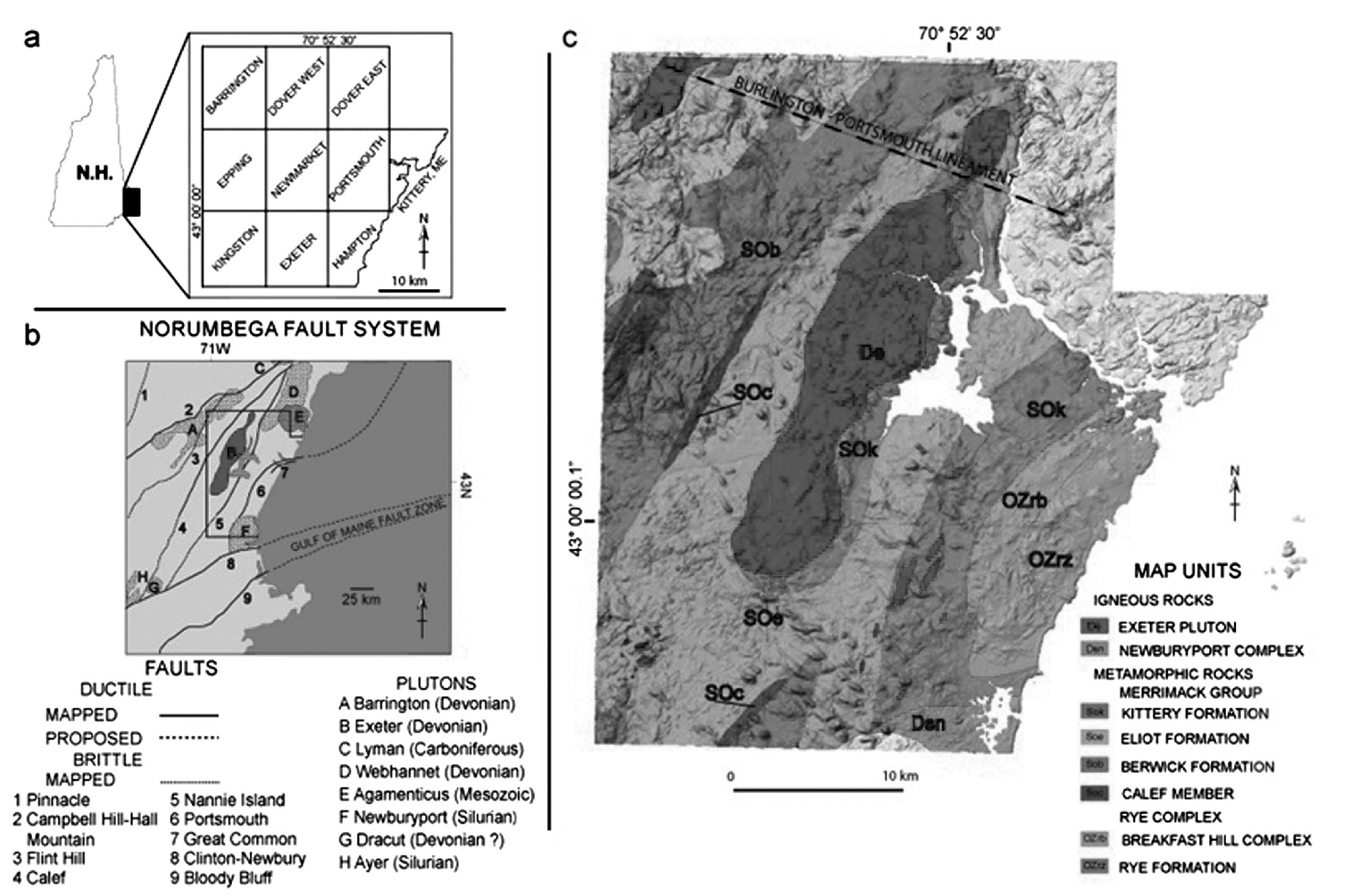
Figure 1 (a) Nine 7.5 minute quadrangles of southeast New Hampshire and one southern Maine quadrangle that make up the study area. (b) Simplified map of the Norumbega Fault System, the polygon outlines the area of the mosaic (adapted from Bothner and Hussey, 1999). (c) Mosaic of merged Digital Elevation Models and high- resolution bathymetry with draped New Hampshire geology from Lyons, et al. (1997).
Intrusive igneous rocks in seacoast New Hampshire consist of the Exeter Pluton and the Newburyport Complex for which Bothner et al. (in Lyons et al., 1997) reported U/Pb ages of 406 ± 1 and 418 ± 1 Ma, respectively. More recently, Bothner et al. (2008) reported new 206Pb/238U dates of the dioritic (407.7 Ma) and the gabbroic (407.4 Ma) phases of the Exeter Pluton. In southwestern Maine, are the Webhannet Pluton (403 ± 14 Ma; Gaudette et al., 1982) and the Agamenticus Complex (228 ± 5 Ma; Brooks, 1990 and references therein). McHone and Butler (1984) included the Mesozoic (210-240 Ma) igneous rocks of the study area into the Coastal New England igneous province.
Northeast-trending fault zones with predominantly ductile dextral shear and superimposed brittle-ductile deformation crosscut the study area (Figure 1b). From east to west these shear zones are, Great Common, Portsmouth, Nannie Island, and Calef (Bothner and Hussey, 1999; Carrigan, 1984; Escamilla-Casas, 2003). The spatial distribution of these presently mapped ductile and brittle faults (northeast trending lineaments, Figure 1b) suggest that these faults extend offshore to the east, following a pattern associated with the Norumbega Fault System of the New England Appalachians (Ludman and West, 1999 and references therein).
Recent investigations indicate that the tectonic activity of the Norumbega Fault Zone (West and Roden-Tice, 2003) intermittently spans, from Middle Devonian to Late Cretaceous time. Moreover, to the north, a northwest-southeast trending prominent lineament that crosscuts the study area is presumably, a segment of the Burlington- Portsmouth topographic lineament (McHone, 1998), (Figure 1b).
In recent tectonic models, the oldest stages of deformation and metamorphism that affected the study area have been interpreted as being associated with the Acadian Orogeny (e.g. Bradley et al., 2000). Alternative models suggest the tectonometamorphic evolution of the area as the result of continuous deformation and metamorphism that initiated in the Late Ordovician and extended into the Permian (Alleghanian Orogeny) e.g. van der Pluijm et al. (1993).
The youngest deformational event imprinted on the bedrock topography of the study area is very likely related to the tectonism associated with the opening of the Atlantic during the Mesozoic, e.g. Swanson (1982). Most geodynamic models relate the Mesozoic rifting between North America and Eastern Africa to mantle plume mechanisms (White and McKenzie (1989); Hill, (1991), and others). However, McHone (1996 and 2000) outlined chronologic and petrologic evidence from mafic dikes and flood basalts that are not consistent with the frame of a mantle plume model as a viable explanation for the opening of the Atlantic Ocean during the early Jurassic time. Furthermore, the younger Early Cretaceous hotspots present in the eastern Atlantic Ocean are responsible for alkaline magmatism that cannot be associated chronologically with rift basalts (Duncan, 1984; McHone, 2000). Nevertheless, both the Early Jurassic and Early Cretaceous geologic episodes are related to the extensional tectonics associated with the opening of the North Atlantic Ocean during the Mesozoic (McHone and Butler, 1984; McHone, 1988 and 2000).
Materials and methodology
For this study, ArcView V. 6.1 was used to retrieve and drape geologic information (Lyons et al., 1997) (Figure 1b) onto land topography, produce a bedrock-topography prediction map, and a topographic lineament map (Figure 2 and 3, respectively). The configuration of these two maps consists of merged high-resolution- bathymetry of Great Bay and Portsmouth Harbor (CCOM-JHC-UNH) with land topography Digital Elevation Models (DEMs) (GRANIT- UNH and USGS). Characteristics of the high resolution bathymetry and inland topography datasets are described by Cutter (2005) and in the UNH GRANIT website, respectively. Land topography of the study area covers three rows, each row containing three USGS 7.5 minute quadrangles: Barrington, Dover East, Dover West, Epping, Newmarket, Portsmouth, Kingston, Exeter, and Hampton (Figure 1a). The offshore dataset covers 839m by 2034m, with the center of the lower left corner grid cell originating at Universal Transverse Mercator (UTM) Northing 4768915m, Easting 360918m (Cutter, 2005). The land topography dataset of each 7.5 minute quadrangle was reprojected from NH State Plane feet, zone 4676 to NAD 27, zone 19 and then merged into a mosaic of nine 7.5 minute quadrangles. Despite the fact that land and offshore datasets are presented on UTM projection (zone 19 north), for merging both datasets, the altitude values in the land topography were converted from feet into meters. In each case, the merging procedure was performed by using the ArcMap V.3.2. Data Management-toolbox merge tool. The resulting merged map presents two levels of resolution, 30 m for the inland topography and 3 m for the seafloor.
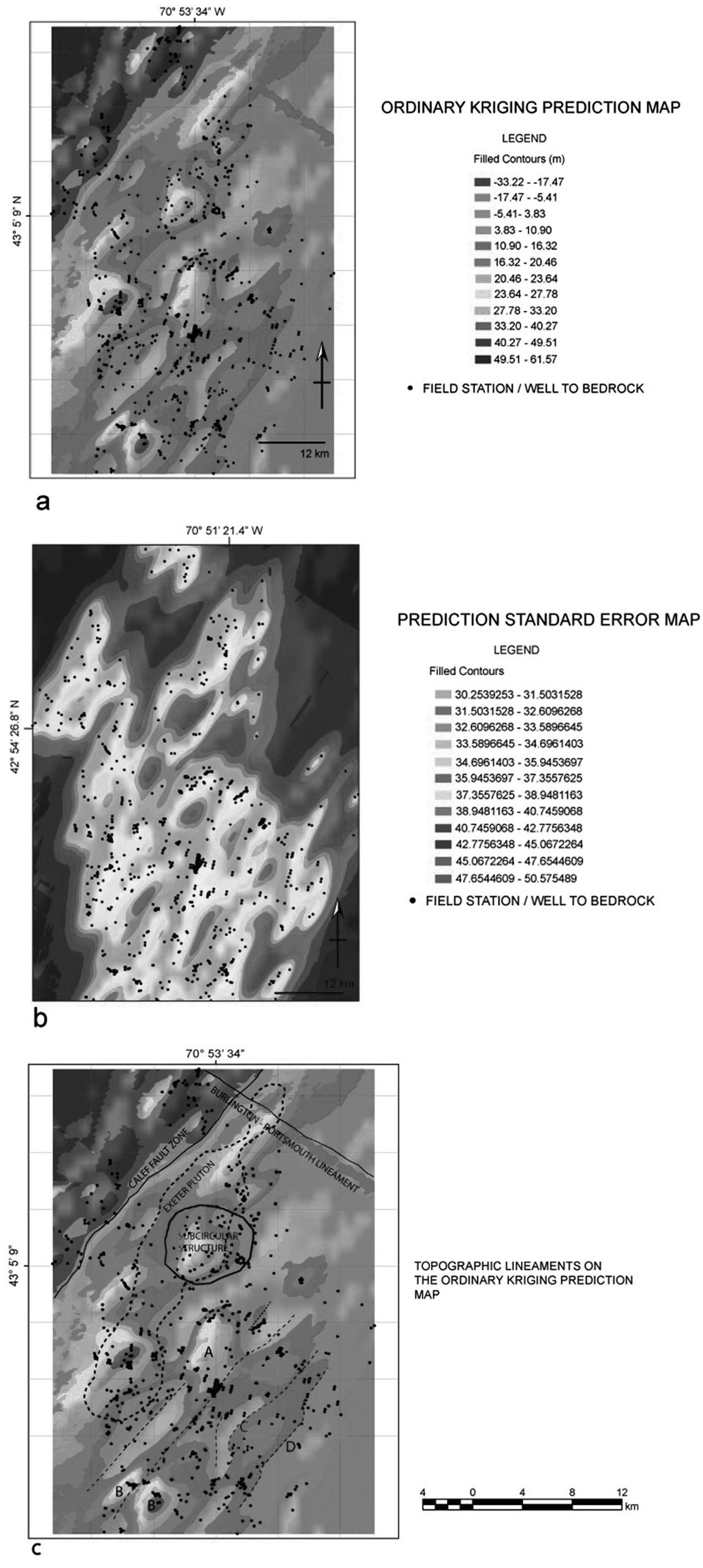
Figure 2 Estimated bedrock topography of the study area. (a) Approximation of the bedrock topography prediction map based on an ordinary Kriging analysis. Contour interval varies from -33.22 m to 17.47 m. (b) Prediction standard error map derived from the ordinary Kriging analysis showing the uncertainty of the predictions. Higher certainty values are indicated in light gray. Contour interval varies from 30.25 to 50.57. (c) Interpretation of topographic lineaments based on the ordinary Kriging prediction map. The configuration also shows major geological features discussed in this paper, e.g. Calef Fault, Burlington-Portsmouth lineament, and the sub-circular structure. For reference, the Exeter Pluton is indicated with a thick dashed line.
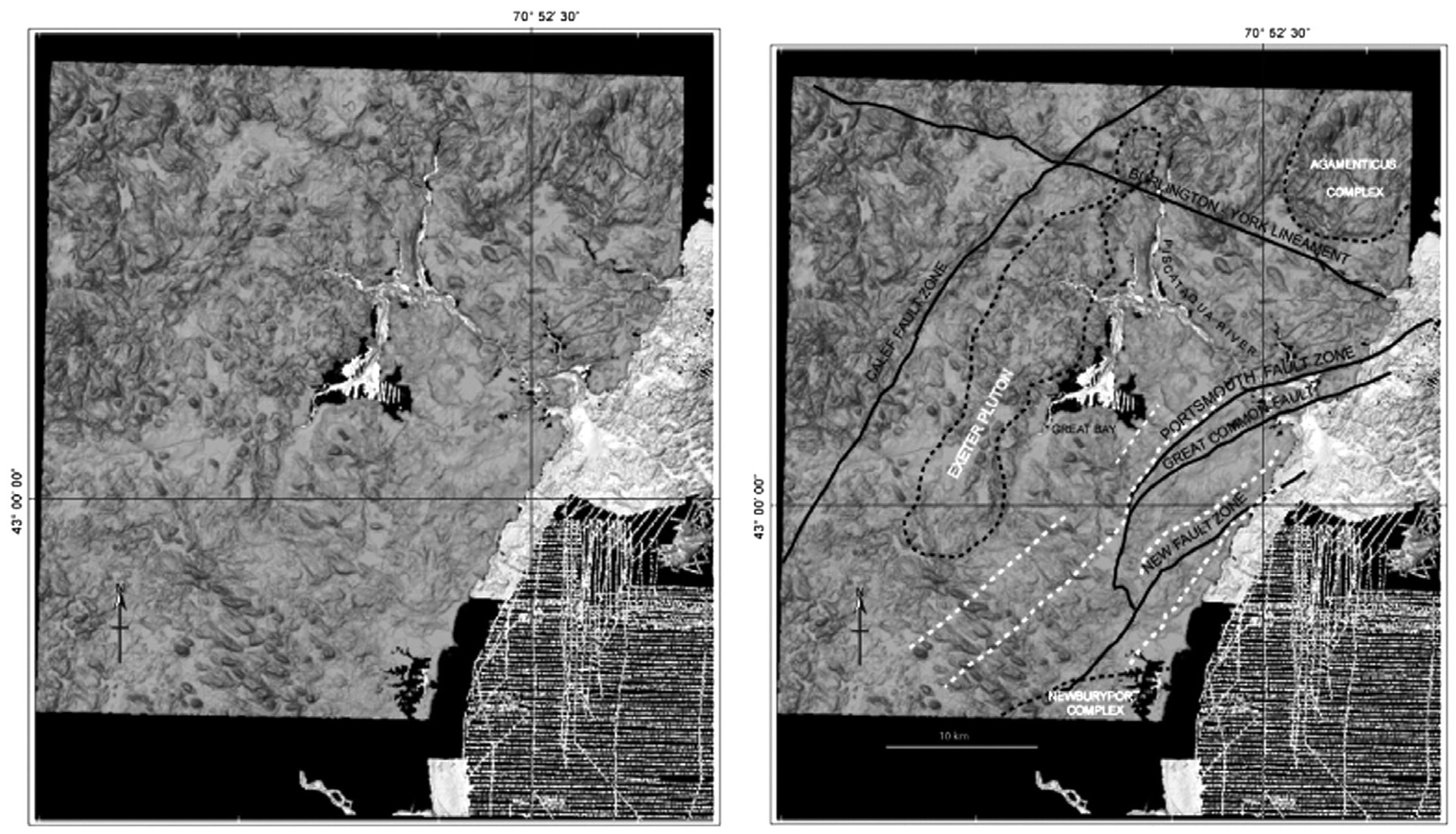
Figure 3 Topographic lineament map interpreted (right) on a mosaic of merged Digital Elevations Models and high-resolution bathymetric soundings of Great Bay, Piscataqua River, and offshore New Hampshire (left). Black dashed lines indicate the location of intrusive bodies and solid lines represent fault zones. White dashed lines indicate the lineaments inferred from the kriging analysis.
ArcMap V.3.26 Spatial Analyst and the ordinary method was used to generate the bedrock-topography prediction map from a 3D Kriging analysis based on location coordinates and elevations of outcrops, and depth to bedrock data from wells (z-values). The generated bedrock-topography prediction map provides evidence that supports the pervasive northwest - southeast structural grain, the presence of the sub-circular structure, and the extent of the Burlington-York lineament.
The ordinary Kriging method was chosen based on the following characteristics: the method is linear, exact, and gives an evaluation of uncertainty for interpolated values. For the ordinary Kriging analysis, 817 records of depth to bedrock data from wells (USGS-WRD and NH DES Water Division) and 56 field stations were used (Figure 2a).
A histogram was generated to show the univariate (depth to bedrock) distribution of the dataset (Figure 4a). The histogram indicates that the dataset is unimodal, fairly symmetric, and hence, close to a normal distribution. Nevertheless, the histogram is slightly skewed to the right. Furthermore, a Q-Q plot was generated to compare the distribution of the dataset with a standard normal distribution (Figure 4b). From the Q-Q plot, it can be seen that the distribution is very close to a straight line therefore, no further transformation was applied.
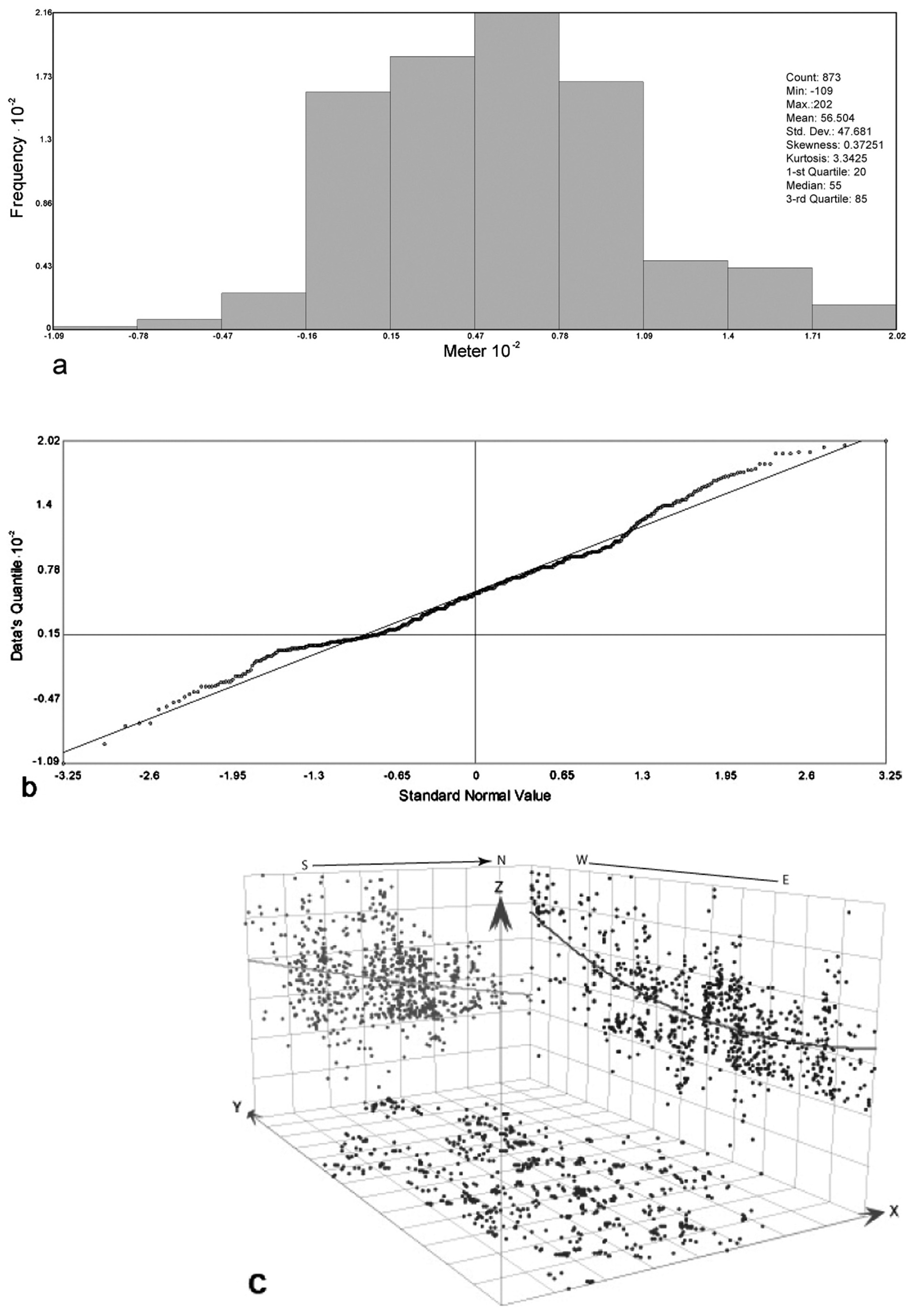
Figure 4 Graphical results of the statistical analysis of the dataset used in the ordinary Kriging analysis. (a) Histogram showing the data distribution. (b) Probability plot (Q-Q Plot) to contrast the distribution of data against the standard normal distribution. (c) Trends in the dataset. The planes X-Z and Y-Z are parallel to the E-W and N-S directions, respectively.
The Trend Analysis tool of the Spatial Analyst, Arc Map 3.2, was used to identify the existence of trends in the N-S and E-W directions (X-Z and X-Z planes of Figure 4c, respectively). Among the identified trends, N-S trend is the strongest. To remove the trends from data and generate the prediction map, a second order-polynomial was applied. Once the Spatial Analyst removed the trends, the statistical analysis was performed on the short range variation component. Before the final prediction map was created, the trends were added back. Therefore, a more accurate surface was produced, because the statistical analysis was performed on the short-range variation component of the surface or the residuals (Figure 2a).
To evaluate the Kriging configuration, a standard error map was used (Figure 2b). The distribution of the highest values of uncertainty in this map reveals that the strength of the ordinary Kriging analysis resides in the midsection of the study area (Figure 2b). Besides the error map, the effectiveness of the Kriging analysis has been successfully tested in this work by contrasting the outstanding features in the prediction map against mapped bedrock geology (Figure 2c).
Modern visualization software (ArcView V. 6.1, Fledermaus, and Adobe Illustrator CS2) was used to change the orientation and elevation of the light source, set up the vertical exaggeration ratios, and select an appropriate false-color map for the DEM. Manipulation and enhancement of the DEM topography with these programs, dramatically improved the definition of the recorded topographic lineaments (Figure 3). In addition to the methodology described by Gantenbein (2012) for creating shaded relief in DEM by using light sources, animation files were used that resulted in enhanced shadows which aided in the identification of new topographic lineaments and the refinement of the traces of mapped lineaments on DEM. These animation files consisted of a set of images of the DEM covering the study area with sequential illumination settings, constant vertical exaggeration, and same false color map. In each file, the illumination settings were spaced 10o along a 360o span at a constant elevation from the virtual horizon. The topographic exaggeration ratio was constant for each set of images ranging from 1 to 6 in all prepared sets. The lack of a specific animation file, that yielded the best possibility to refine the traces of the topographic lineaments, is due to the low topographic relief to the southeast of the study area, the extensive swamp area, structural grain, and topography dominated by glacial deposits.
To further investigations on the topographic expression of the most prominent topographic lineaments, the Fledermaus computer program was used to generate topographic profiles from merged DEM. In all cases, the profiles are perpendicular to the trace of the lineaments.
A field structural analysis of the rocks affected by the sub-circular structure was conducted in order to confirm its occurrence and to support the observations that were made on the DEM and Kriging analysis. Data sets of the attitude of joints, shear fractures, and slickenfibers were collected and analyzed from outcrops inside the presumed sub-circular structure boundary and along its periphery. Following the theory outlined by Dyer (1988), the interactive geometry of different sets of systematic joints allows the determination of their relative ages. Thus, for interpretation purposes, we considered each set of joints as a separate jointing episode associated with a stress field. Therefore, results of this structural analysis documents the orientation of the regional stress acting on the study area over time, as inferred from the superposition of multiple joint sets.
Results
Bedrock topography Configuration
In an earlier work, Escamilla-Casas (2001 and 2003) presented bedrock topography configurations of the Exeter and Hampton USGS 7.5-minute quadrangles based on depth to bedrock data estimated from 220 drill logs (USGS-WRD and NH DES Water Division) and outcrop elevations. Those configurations failed to identify the extension of the Merrimack Group, but showed the presence of minor intrusions similar to the Exeter Pluton, which occupies topographic highs. In this paper, a configuration of the bedrock topography covering a larger area and a larger data set is presented.
Figure 2a presents an ordinary Kriging prediction map which subdivides the bedrock topography into twelve contoured classes, ranging from -33.22 m to 61.6 m (-109 ft to 202 ft) relative to present sea level. The highest and lowest topographic values occur in the northwest and southeast portion of the map, respectively, accentuating a prominent contrast in elevation along a southwest - northeast trending sharp boundary.
Map contours delineate a southwest to northeast-trending fabric (Figure 2a), which stands out and coincides with the orientation of most of the bedrock geologic structures identified in the study area (Figure 1a). For instance, the sharp northeast-trending boundary between topographic highs and lows coincides with the trace of a strongly defined northeast-southwest lineament on the DEM that corresponds to the Calef Fault Zone (Figure 1b, 2a, and 2c). In the upper central section of the ordinary Kriging prediction map (Figure 2a) there is a topographic high surrounded by topographic lows suggesting the presence of a circular-shaped structure (Figure 1, 2a, and 2c). This circular-shaped topographic high, which is also observable in the present topography and the DEM, will be discussed and detailed in a separate section of this paper.
The two lowest topographic values in the ordinary Kriging prediction map are aligned along a northeast-southwest-trending line defining a trough (Figure 2a). The trough is separated by a local high (labeled A in Figure 2c). If the trough corresponds to a geologic structure, such a feature must be deeply imprinted in the bedrock topography. The trend of this deep linear structure probably extends to the southwest, as shown by the topographic low to the south. At present, there is no geologic structure mapped in that specific location, but the Nannie Island Fault Zone (Figure 1) crops out in two nearby locations along strike (Escamilla-Casas, 2003). Furthermore, the presence of abundant Exeter Pluton-like satellitic bodies in the area could be responsible for the discontinuous nature of the inferred trough (Escamilla-Casas, 2001).
Along the southern border of the ordinary Kriging prediction map, two topographic highs occur close to each other (labeled B in Figure 2c). The topographic high to the northwest has an elongated shape and is oriented parallel to the predominant structural grain in the area; the other has a round shape and thus, does not have a preferred orientation. These two features are separated by a narrow topographic low that can be connected along strike with more topographic lows to the northeast, thus defining the trace of a topographic lineament.
Characteristic of the south portion of the study area is the extensive cover of glacial sediments and swamps resulting in limited outcrop exposure, making field geological mapping difficult. Therefore, topographic lineaments and traces of geologic structures are poorly controlled on the surface of these areas due to a low topographic contrast. However, lineaments in the prediction map, although not prominent, assist in the fine-tuning of the traces of shear zones in this area, particularly, the Great Common and Portsmouth fault zones (Figure 1b). The prediction map shows a curved lineament (labeled C in Figure 2c) merging with a northeast-southwest trending lineament at its southern extent (southeast corner, labeled D in Figure 2c). Based on similarity of trends, it is suggested that the curved lineament corresponds to what is known as the Portsmouth Fault Zone, and the north-east-trending lineament is related to the Great Common Fault (Figure 1).
In the northeastern corner of the study area, the ordinary Kriging prediction map shows an incipient northwest-southeast trending lineament that is perpendicular to the predominant Northeast-Southwest fabric (Figure 1, 2a, and 2c). This lineament is not present in the Geologic State Map (Lyons, et al., 1997), but it is consistent with previous interpretations that recognize a NW-SE trending structure in the area (e.g. Ballard and Uchupi, 1972; Birch, 1979; Hussey and Pankiwsky, 1976; Stewart, 1971; among others). McHone (1998) described it as the Burlington - Portsmouth Lineament (Figure 1b and 2c) and interpreted it as being related to the opening of the Atlantic Ocean during the Mesozoic.
Topographic Lineaments
The topographic lineament map that is presented here (Figure 3) includes the analysis of lineaments observed on both, inland topography and high-resolution-bathymetry of the seacoast of New Hampshire. Onshore, the present topography shows a pervasive northwest - southeast structural grain that consists of glacial deposits characterized by discontinuous and elongated topographic highs, and a less persistent northeast - southwest grain. The lineament map shows a strong contrast between topographic highs and lows in the northwest edge of the study area (Figure 3), similar to the prediction map presented in the previous section (Figure 2a). Topographic profiles show that this topographic contrast corresponds to the Calef Fault Zone and consists of a lineament characterized by both, slopes gently dipping to the northwest and slopes steeply dipping to the southeast (Figures 3 and 5).
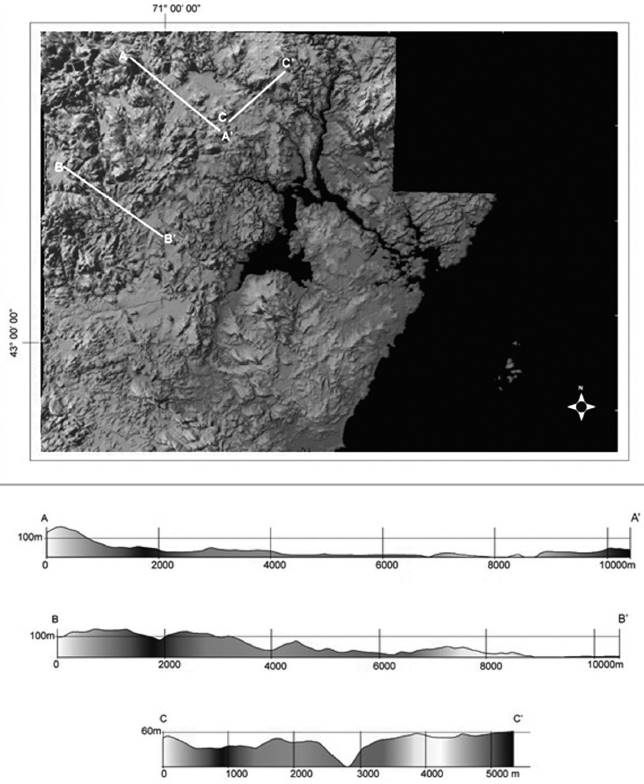
Figure 5 Mosaic of Digital Elevation Models of the study area showing the location of the topographic profiles (see text for explanation). Profiles A-A' and B B' show the difference in elevation along the Calef Fault Zone. Profile C-C' shows a deep topographic feature that corresponds to the Burlington-York topographic lineament.
Sections A-A' and B-B' are northwest to southeast-trending topographic profiles perpendicular to the trace of the Calef Fault Zone (Figure 5). These topographic profiles show that the elevation to the west is higher than to the east, and that the topographic lineament defining the trace of the Calef Fault Zone has, locally, a difference in elevation of approximately 110 meters.
A single, well-defined, west-northwest to east-southeast trending prominent lineament crosscuts the uppermost portion of the study area (Figures 3 and 5). A topographic profile (Section C-C' on Figure 5) perpendicular to the trend of this lineament shows that it consists of a deep topographic low with a marked elevation contrast on both sides, where to the north of the lineament the elevation is higher than to the south. This lineament extends to the east offshore as it is observed on the bathymetry, proving that the lineament is imprinted on the seafloor topography (Figures 3, 5 and 6). Based on the lineaments location and trend, it is being suggested that this lineament very likely corresponds to a segment of the Burlington-Portsmouth Lineament described by McHone (1998). Since the trace crosses through York Harbor in Maine instead of Portsmouth, New Hampshire, the authors suggest that Burlington-York Lineament is a more appropriate name.
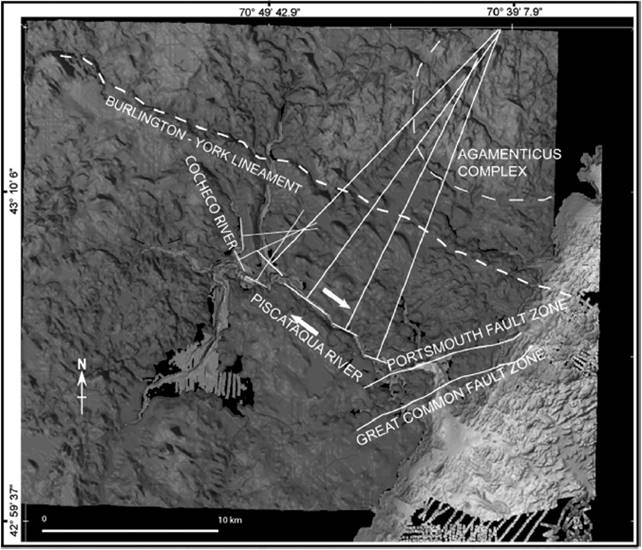
Figure 6 Traces of Euler poles to the long segments of the course of the Piscataqua and Cocheco rivers on a mosaic of merged Digital Elevation Models and bathymetry, converge at different points. However, both poles are close to the center of the Agamenticus Complex. For reference, the traces of the Portsmouth and Great Common fault zones and the Burlington-York lineament are indicated.
The stepping up to the northwest en- echelon array of the course of the Piscataqua River can be estimated by Euler Pole analysis (Figure 6), by tracing perpendicular lines to the long segments of the steps. The resulting plot shows that the lines converge on a sector located close to the center of the topographic high where the Agamenticus Complex crops out. Nevertheless, perpendicular lines to the long segments of the course of Cocheco River define a different Euler Pole.
To the south and southeast regions of the study area, the low topographic relief obscures the identification and tracing of lineaments (Figure 3). Nevertheless, the illumination settings and shadow contrasts of the animation files aided with the identification of lineaments, which can be traced off-shore and connected with those shown on the bathymetry of Portsmouth Harbor (Figure 3). Based on descriptions of previous authors and the trends of the traces identified in Gerrish Island and Newcastle (e.g. Hussey, 1980; Carrigan, 1984), these lineaments likely correspond to the Portsmouth and Great Common faults zones (Figure 1, Figure 3). However, the inland continuation of these lineaments to the south suggests that these faults eventually merge onshore. This convergence of faults is also consistent with previous interpretation of the fault trends in the area (e.g. Lyons et. al., 1997). Escamilla-Casas (2003) published a map showing the traces of the Portsmouth and Great Common Fault Zones merging to the south, which is consistent with the lineament pattern presented in this paper.
A more recent geologic map of the area shows a new fault zone to the south of the Great Common Fault Zone (Bothner et al., 2004). This new fault zone extends to the east and merges with both, the Portsmouth and Great Common fault zones in its southern extent. Lineaments corresponding to these faults continue offshore to the northeast, as shown on the bathymetry of Figure 3. The orientation and location of these lineaments, which are parallel to the trace of the Norumbega Fault System described by Ludman and West (1999), indicate that the new fault, the Great Common, and Portsmouth fault zones, likely belong to the Norumbega Fault System. The authors propose the name of Hampton Fault Zone for the new fault, as Hampton is the main locality of the fault.
Sub-circular Structure
In plan view, a composite image of the merged digital terrain models and high-resolution bathymetric soundings suggests the presence of a circular structure bounded to the north by the Oyster River, to the south by the Lamprey River, and to the east by the Great Bay (Figures 2c and 7). The perimeter of the identified sub- circular structure is approximately 24 km long and covers an estimated area of 31 km2. Its long and short diameters are 7.2 km and 5.5 km long, respectively.
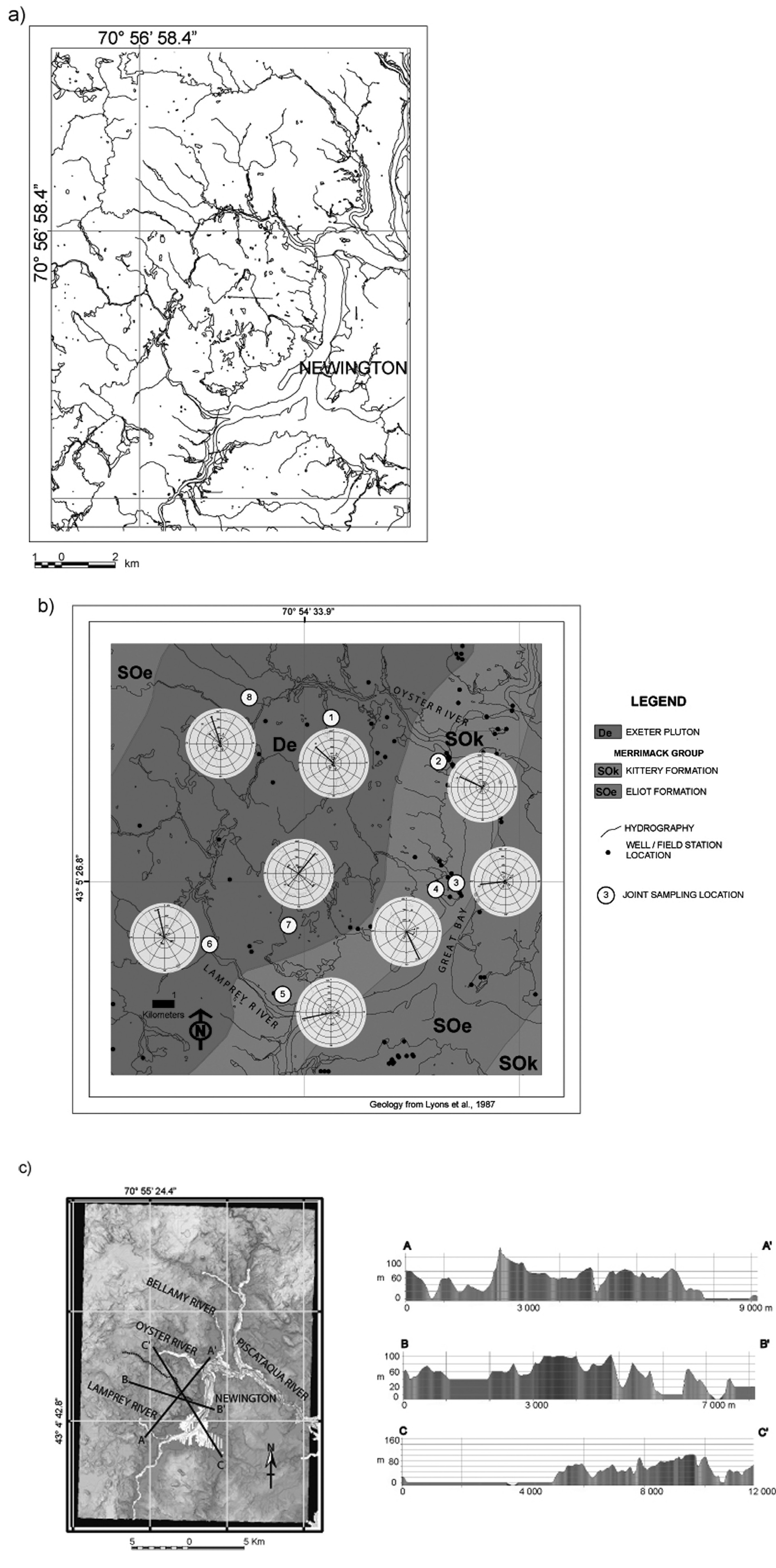
Figure 7 Location of the sub-circular structure on the study area. (a) Radial drainage pattern delineating the periphery of the sub-circular structure. (b) Simplified geologic map of the sub-circular structure showing the joint sampling locations. For each field station, illustrations of the polar plots indicating the dip, dip direction, and relative percentage of occurrence of each joint set are shown. (c) Mosaic of merged Digital Elevation Models and bathymetry of Great Bay showing the location of the three topographic profiles. The topographic profiles delineate the boundaries of the sub-circular structure. A northwest- southeast-trending-normal fault (block down to the northeast) crosscuts the sub- circular structure.
While a radial drainage system is present outside the sub-circular structure's boundary, a deranged pattern developed inside the structure (Figures 7a). The original drainage inside the structure was, very likely altered by fine-grained glacial deposits that formed wetlands and impounded streams resulting in the formation of small lakes. Both, wetlands and small lakes are common features present in the geomorphology of this area.
Three topographic profiles (A-A', B-B', and C-C'; Figure 7c) show that the sub-circular structure is elevated with respect to the surrounding rock topography and slightly tilted to the west (Figure 7c). These profiles depict a prominent topographic high close to its center and a deep channel-feature that bounds the structure to the east. The presence of this channel is also revealed by the high- resolution bathymetric soundings of Great Bay and by the Kriging analysis (Figures 8 and 2a, respectively). Moreover, the soundings and Kriging analysis indicate that the channel is imprinted on the bedrock topography, discarding any possible association with soft sediment deposits (see DEM, Figure 3 and bathymetry in Figure 8).
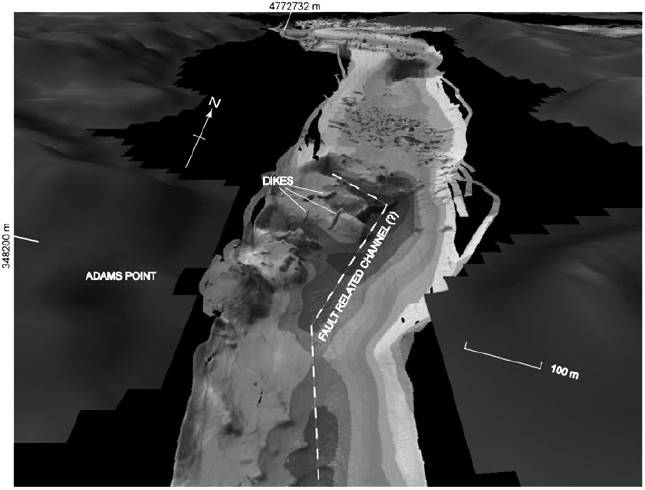
Figure 8 Image generated from high-resolution bathymetric soundings of Great Bay to the east of the sub- circular structure. The image shows the presence of dioritic dikes, which are also traceable on the surface and illustrates the inferred fault-related channel that bounds the sub-circular structure to the east.
Gravity surveys show that the Exeter Pluton presents a positive Bouger gravity anomaly in excess of 16 Mgals (Bothner, 1974) in the location of the sub-circular structure. Two and three-dimensional models based on gravity surveys in this area also suggest the presence of a 1-3 km thick plutonic body with both, a southeastern steep contact and a shallower northwest contact with the host rock. Additionally, aerial magnetometric surveys revealed anomalies related to the Agamenticus Complex in this region (Bothner and Hussey, 1999; Brooks, 1990).
Within the sub-circular structure, data sets of joints were grouped into two domains, each domain defined upon the dominant rock type where the joints occur (Figure 7b, Table 1). Domain 1 defined from the intrusive rocks from the Exeter Pluton and Domain 2 defined from the metasediments of the Merrimack Group (Kittery Formation). In both domains, the joint sets present a strong variation in the number of joint planes per meter (joint frequency). However, the orientation of the joints can be grouped into three main sets, regardless of the domain in which they occur. Table 1 summarizes the orientation (predominant strike and dip) of the joint sets observed within each rock domain.
Table 1 Summary of the Joint set orientations in each domain.
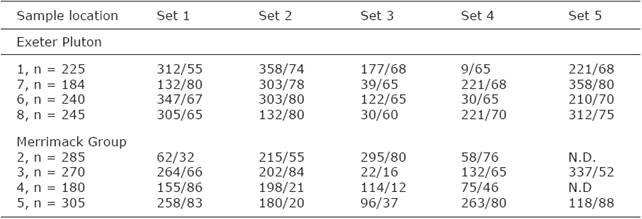
Notes: • Values indicate the average dip direction (azimuth) and dip angle (degrees) of each joint set.
• Refer to Figure 6b for locations.
• n = sample population.
To analyze the variation of joint frequency and its spatial distribution through the study area, a polar plot of the vectors representing the relative percentage of occurrence and the average dip and dip direction of each joint set was created for each joint sampling location (Figure 7b, Table 1). The spatial distribution of the regions with higher joint frequency delineates the areas where prominent structures occur. Crosscutting relationships indicate that rocks of the Merrimack Group are older than the Exeter Pluton, and thus it is inferred that joints older than the age of emplacement of the Exeter Pluton might exist in the Merrimack Group. However, the orientation and crosscutting relationship of joints in each domain permitted the identification and establishment of the joints relative chronology (sequence of formation) to be made and identify the joints that are related to the mechanisms of the intrusion. A comparison of the attitude between joint sets of the two domains also aided with the identification of the overall relative chronology. Joint sets were investigated at eight field stations (Figure 7b, Table 1), four of them located within the Merrimack Group and four within the Exeter Pluton.
At least five distinct sets of joints are present in the rocks of the Exeter Pluton (Domain 1, Joint Sampling Locations 1, 6, 7, and 8, on Figure 7b; Table 1). At Location 1, the oldest set of joints dips 74° to the northwest and it is crosscut by a conjugate set of joints dipping 65° to the northeast and 68° to the south. A second set of joints is present dipping 68° to the southwest; its relative age with respect to the previously described sets is uncertain. A third set of joint planes (the youngest) dips 55° to the northwest and has the highest frequency. At location 6, two main sets of conjugate joints have been observed. Joints that belong to the older set dip 65° to the northeast and 70° to the southeast, while a younger joint set dips 67° to the northwest and 65° to the southeast. At this location, the third and youngest joint set dips 80° to the northwest, and has the highest joint frequency. At location 6, a few joint surfaces contain slickenfibers that indicate a south block down vertical displacement. At Location 7, the oldest joint set dips 80° to the northwest and is crosscut by two conjugate sets: one with planes dipping 65° to the northeast and the other dipping 68° to the southwest. The youngest joint set dips 78° to the northwest and 80° to the southeast. At Location 8, the oldest conjugate set of joints dips 60° to the northeast and 70° to the southwest. A younger conjugate set dips 75° to the northwest and 80° to the southeast. The set with highest frequency of planes is the youngest in this location and dips 65° to the northwest.
Analysis of joints from locations 1, 6, 7, and 8 (Figure 7b) indicates that the Exeter Pluton has two conjugate sets of joints: one set dipping to the northeast and to the southwest, and a younger set dipping to the northwest and to the southeast. Following the interpretation of Dyer (1988), the geometry of these conjugate joint sets suggests that during their formation, the principal tectonic stress was vertically oriented. In locations 5, 6, and 8 (Figure 7b) joint planes with dip directions tangential to the circular structure have the highest frequency. Locations with high joint frequency around the elevated sub-circular structure indicate that this structure was significantly affected by brittle deformation, and shows the presence of other structures, for instance, a fault that bisects the sub-circular structure (Figure 7c). In all joint sets within the Exeter Pluton, the youngest set has the highest frequency of planes (Sample Location 1).
Each field station in the Merrimack Group contains at least four sets of joints (Joint Sampling Locations 2, 3, 4, and 5 of Figure 7b; Table 1). Rocks in field stations of the Merrimack Group are characterized by higher joint frequency than the rocks of the Exeter Pluton. At location 2, the oldest joint set dips 76° to the northeast and it is crosscut by a conjugate set of joints dipping 32° to the northeast and 55° to the southwest. Here, the youngest set has the highest frequency of joints, with planes steeply dipping to the southwest. On these joint planes, slickenfibers indicate a north block down vertical displacement. At location 3, the oldest joint set dips 16° to the northeast and with a conjugate set dipping 84° to the southwest. This conjugate set is crosscut by two sets of joints, one dipping 52° to the northwest and the younger set dips 65° to the southeast. The youngest joint set contain the highest frequency of joint planes, is characterized by planes dipping 66° to the west, and contain slickenfibers that indicate an east-block-up vertical displacement. At location 4, the oldest conjugate set of joints dip 46° to the northeast and 21° to the southwest and are crosscut by a joint set that dips gently to the southwest (12°). The highest frequency of joints corresponds to the youngest joint set with planes dipping 80° to the southeast. These planes also contain slickenfibers indicating vertical (north block up) and horizontal (to the west) displacements. At location 5, the oldest set consists of conjugate planes that dip 37° to the east and 80° to the west, and are crosscut by a younger conjugate joint set characterized by sub-vertical planes. The two previously described conjugate sets are crosscut by a set of joints with planes that dip gently (20°) to the south. The youngest joint set at location 5, dips steeply to the southwest and have the highest joint frequency. Slickenfibers are observed on the planes of this youngest set, but cannot be used as kinematic indicators at this location.
Analysis of the general orientation of joint sets from locations 2, 3, 4, and 5 (Figure 7b; Table 1) indicates that conjugate sets of joints have variable orientations in the Merrimack Group, and thus, the interpretation of the stress fields is uncertain in this unit. At each location 2, 3, and 4, (Figure 7b and Table 1) the oldest conjugate set of joints have planes that variably dip to the northeast and to the southwest. The variation in the orientation of these joint planes is likely influenced by the anisotropy inherent to bedding and the Acadian folding of the meta-sediments. Furthermore, it is likely that the Exeter Pluton fractured the host rocks during or after its emplacement, producing most of the joint sets. In all locations within the Merrimack Group, the strike of the younger set of joints is tangent to the presumed sub-circular structure and the slickenfibers on the joint planes indicate vertical displacement. This is consistent with the vertically oriented tectonic stress that is interpreted from the joint orientation present in the rocks of the Exeter Pluton. Hence, both, the orientations of joint planes and kinematic indications from slickenfibers of the youngest set of joints in both domains, support the hypothesis of the presence of a sub-circular structure bounded by a brittle fault with vertical motion. The variability of sense of vertical movement, inferred from kinematic indicators preserved on joint planes in both domains, suggests reactivation of the vertical displacement along the fault with respect to its host rock at different time.
Tectonic Model
The tectonic interpretation of the geological evolution of the area, takes into consideration that the emplacement of the pluton, which is presumably underneath the circular structure, occurred under an extensional regime that prevailed during the Mesozoic. Thus, such intrusion is responsible for influencing the evolution of Great Bay tidal estuary and the geometry of the course of the Piscataqua and Cocheco rivers in times of the opening of the North Atlantic Ocean. This innovative extensional model contains the following stages:
First, during the Mesozoic, the Agamenticus Complex intruded rocks of the Merrimack Group. Due to the intrusion, the surrounding crust was subjected to tensional stresses (Figure 9a). As a result, and according to the Euler Poles analysis, the breakup of the crust produced a set of fractures in an en-echelon array that later was occupied by the drainage system that led to the formation of the present course of the Piscataqua River. The en-echelon array implies breakup resolved by pull-apart and strike slip faulting, produced by the motion of a rigid segment of the crust on the curved surface of the Earth about an approximately rotation pole or the Euler pole. The presence of the preexisting Exeter Pluton may have refracted the intrusion-related fracture trend forming the branch that corresponds to the present course of the Cocheco River.

Figure 9 Tectonic model proposed in this study. (a) The initial stage in this model suggests that the emplacement of the Agamenticus Complex generated the extensional regime. The extension produced a set of fractures that defined the trace of the present course of the Piscataqua River. The presence of the preexisting Exeter Pluton refracted the trace of the extension fractures generating the trace of the present Cocheco River. (b) The emplacement of an intrusive body, probably associated with the Agamenticus Complex, did not have the buoyancy to completely remove the Exeter Pluton and Merrimack Group cap rock. During the emplacement of this intrusive body, a rising movement was followed by subsequent collapse after the cooling stage. As a result of this vertical movement, brittle deformation was imprinted on the host rocks. (c) Finally, glacial erosion of the softer metasedimentary Merrimack Group rocks shaped the present Great Bay.
Second, it is probable that an Agamenticus- like igneous body was emplaced in the middle section of the Exeter Pluton (Figure 9b). Although this ascendant pluton did not have the buoyancy to remove the overlying rocks completely, its rising vertical movement imprinted brittle deformation on the Exeter Pluton and nearby rocks of the Merrimack Group. After cooling, the intrusive body very likely collapsed moving vertically again. This resulted in the ambiguous sense of vertical movement that is inferred from the slickenfibers observed on the joint planes. From the structural analysis and the lack of other structures, it is inferred that the concentration of brittle deformation related to each vertical movement occurred along the fault that surrounds the sub-circular structure. Based on gravity surveys, the 1-3 km thick intrusive body may be responsible for the positive Bouger anomaly of the Exeter Pluton; its correlation with the Agamenticus Complex is based on aerial magnetometry.
The formation of the topographic low near the Exeter Pluton, and subsequent events (intrusion of plutonic bodies and youngest imprint of brittle deformation), was very likely part of the initial stages of formation of the actual Great Bay during the lower to mid Paleozoic. The presence of northwest to southeast trending drumlins and several other distinctive glacial deposits indicate that glacial erosion was intense in the lower east portion of Great Bay during the Quaternary (Fig. 9c). The glacial erosion was particularly strong where the less competent metasedimentary rocks of the Merrimack Group are predominant. Consistent with a glacial origin, the lower east branch of Great Bay is oriented northwest to southeast paralleling the general trend of glacial deposits in the study area.
Discusion
The use of DEMs facilitates the interpretation of the bedrock geology in areas of poor rock exposure in the seacoast area of New Hampshire. In this study, the results of the analysis of the lineaments observed on mosaics of merged DEMs and high-resolution bathymetric soundings were used to refine the traces of lineaments, which mostly correlate to previously mapped fault zones. To support the interpretation of the traces and the identification of a sub-circular structure nearby the Exeter Pluton, a prediction map based on x-y-z data (location coordinates and borehole depth to bedrock elevations) of the bedrock topography was constructed and supplemented with information from current geologic maps.
In the middle portion of the Exeter Pluton, the present topography defines a radial drainage pattern, and the bedrock topography prediction map shows a topographic high that delineates a sub-circular structure. In this location, field analysis of brittle structures confirms the presence of a circular fault that bounds the topographic high.
The structural analysis of slickenfibers on jointed planes inside the sub-circular structure, suggests that the structure was formed due to vertical displacements that is hypothesized to be related to the emplacement of an intrusive body that presently is not exposed. The mechanisms of emplacement of the intrusive body jointed and faulted (extensional regime) the overlaying host Exeter Pluton and Merrimack Group rocks, but was not strong enough to remove the cap. The existence of the sub-circular structure is consistent with the presence of structures associated with plutonic bodies in the bedrock of New Hampshire. Furthermore, the proximity of the Agamenticus Complex to the proposed sub-circular structure also supports its likely association with the plutonism that prevailed during the Mesozoic.
In the proposed tectonic model, the fault that surrounds the sub-circular structure was responsible for the formation of Great Bay. Also, according to this model, Great Bay was a topographic low from which a northeast- southwest trending rivers formed during the Quaternary. The river was enlarged and reshaped as a result of glacial erosion and sedimentation processes.
Euler Pole analysis of the course of the Piscataqua River suggests a right-lateral extensional regime that is consistent with its en-echelon pattern, which is very likely related to the emplacement of the Mesozoic Agamenticus Complex during the opening of the Atlantic Ocean. For the Euler Pole analysis, it is assumed that during the emplacement of the Agamenticus Complex, some rotation of the rigid crust occurred and originated the right lateral shear. The course of York River, which is near the Agamenticus Complex, might not have been affected by the intrusion because it is a younger feature associated with the Burlington-York Lineament. It is likely that the current topography is also affected by the interaction of the Devonian Webhannet Pluton with the Mesozoic Agamenticus Complex.
Conclusions
The pervasive northeast-southwest structural grain of the bedrock geology of Seacoast New Hampshire and southwestern Maine is evident on both mosaics of DEMs of inland topography merged with offshore high-resolution bathymetry, and on a configuration of the bedrock topography based on Kriging analysis.
On bedrock (inferred) and surface topographies, lineaments were identified that are associated with the trace of fault zones that likely belong to the Norumbega Fault System. Computer animation files with images of the topography facilitated the identification of lineaments and the refinement of traces of presently mapped faults. High-resolution- bathymetry of the seafloor aided in the identification of the trace of the lineaments and supports the continuation of the fault trace offshore.
The use of modern visualization software and topographic profiles helped to determine that the Calef Fault Zone and the Burlington- Portsmouth Lineament are topographic features deeply imprinted on bedrock topography. Moreover, Geographic Information Systems, topographic data, and field structural data from rocks of the Merrimack Group and Exeter Pluton, aided in the identification and delineation of a sub-circular structure. It is hypothesized that the sub-circular structure formed as a result of a failed extrusion of a plutonic body associated with nearby Mesozoic plutonic bodies. It is interpreted that the failed extrusion imprinted brittle deformation on the host rock and produced the subsequent tilting of the rock cap triggering the formation of the Great Bay estuary that was subsequently reshaped by glacial erosion. Similarly, the extension and breakup of the crust during the intrusion of the Agamenticus Pluton determined the trace of the present course of the Cocheco and Piscataqua rivers.
These observations of brittle structures, surface topographic features, high resolution bathymetry, and predicted bedrock topography lead to the postulation of a tectonic model that explains the origin and formation of the Piscataqua and Cocheco rivers, and the Great Bay estuary.











 nueva página del texto (beta)
nueva página del texto (beta)


